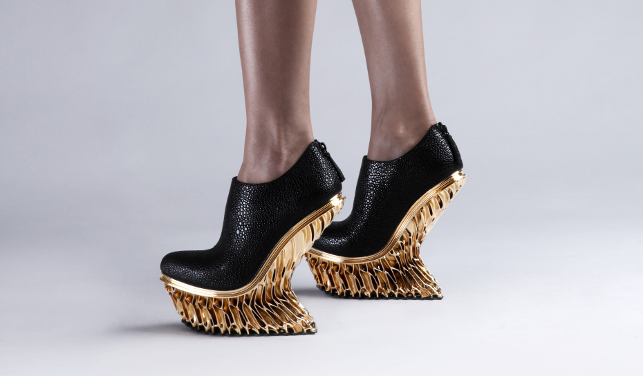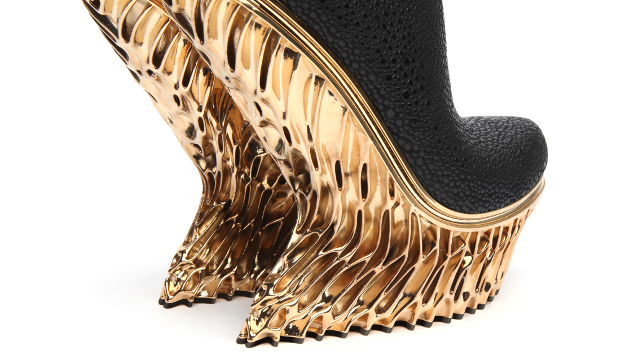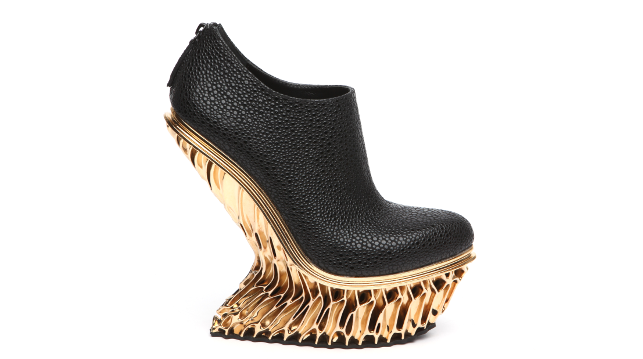Mass customisation is still some way off for the fashion industry, says Sarah Krasley, but a pair of 3D Printed shoes seen at New York Fashion Week holds some important clues about how it might be achieved

As New York Fashion Week draws to a close, the ubiquitous white tents are taken down and rolled up. The red velvet ropes and their brass stanchion posts stand crowded together in warehouse corners. Lighting rigs are ratcheted down and disassembled until next February, when they’ll be called into service again, to make the Fall/Winter 2016 collections come alive.
The glamour and dazzle of this twice-yearly circus stands in stark contrast to what we normally experience in the product design world. Because of that, for a long time, I thought fashion was pure frivolity — a silly distraction.
But recently, I’ve come to admire its substance and the important role it plays in society and culture. Perhaps it’s maturity.
Perhaps it’s just a need to justify a recent, costly boutique visit. Either way, I’m starting to understand how fashion really is the product category that most often helps an individual express themselves to the world.
A simple choice of jacket or pair of shoes, after all, tells the world a little bit about your personality, mood or the ‘tribe’ you feel you belong to.
Or perhaps I’m warming to fashion because I’ve been paying close attention to the efforts of ready-to-wear garment and footwear companies to make mass-customised products a reality and to monetise the process, enabling customers to take personal self-expression one step further.
Brand dilution worries
The notion of customer-led personalisation of apparel is a tricky thing for an established brand.
Some within the design and manufacturing community want to believe that every person in the world is a designer at some level or that they can clearly articulate what would make for a good fit. They assume that everyone wants to let their creativity run wild over a jacket or a pair of trainers.

But early attempts at making design platforms available to end customers have seen, more often than not, lacklustre take-up rates and confusing user interfaces, with incongruent sliders and overwrought dropdown menus.
Even if the customer were able to navigate the sliders, menus and options, once they’ve created their item, there’s the problem for the apparel company of putting its logo on something designed by a customer who perhaps might not have stuck to design guidelines.
A few isolated instances of monstrous personal expression going viral may not cause sleepless nights over brand erosion. But over time, and in the absence of clear boundaries enforced by customisation platforms, an established brand might run the risk of diluting the elements that make its designs instantly recognisable.
In other words, what many apparel designers are looking for is a way to deliver personalised items to customers on a mass-market scale, but still keeping careful control over those essential elements that make their designs special, that make them covetable among a wide audience.
Meet Mutatio
Most of the designs paraded down the catwalks of New York Fashion Week were created for the mass market, with a few exceptions.
Perched stoically under a spotlight in a storefront on Bond Street, as passing fashionistas negotiated the cobblestones on the street outside, were the results of an interesting collaboration that explores a different path towards mass customisation in footwear.

Meet Mutatio, a collaboration between designer Francis Bitonti, shoe company United Nude and 3D printing specialist 3D Systems.
Francis Bitonti is an architect-turned-designer who leads the Brooklyn-based studio that bears his name. I like the general attitude of Bitonti’s studio and the boundaries pushed there, but what I am most impressed with is the wide variety of projects it takes on.
For example, Francis Bitonti Studio has worked on projects as diverse as public bicycle-parking stands for New York City, an iconic 3D-printed dress for Dita Von Teese and a collaboration with Nanotronics on a 3D-printed machine cover for a nanoscale microscope. To say the least, the studio’s work straddles many worlds.
The mass-customisation footwear project with United Nude and 3D Systems, meanwhile, sprung from a friendship between Bitonti and Rem D Koolhaas, creative director and co-founder of United Nude (and yes, nephew of the famous architect of the same name).
Bitonti had already been working on a jewellery collection, exploring mass customisation with 3D Systems, so the three extended the concept to include shoes and away they went. The collaboration flowed smoothly, with Koolhaas and Bitonti iterating back and forth on the shoe design.
The Mutatio stands at about 12” tall (including its 6” platform) and is comprised of embossed cowhide uppers that tower over a stunning 18K gold plated, SLA-printed sole. It looks like something I would not dare wear in the rain or on a solitary late-night walk down a desolate street.
The future of customisation?
One of my favourite aspects of Mutatio is the texture and shape of the sole. And what’s particularly clever here is the scope for personalisation.
Each single pair of shoes in the collection has a unique sole, featuring a slightly different mesh pattern, generated by tweaking an algorithm created by Bitonti that controls the form of a digital model.
Once that version of the algorithm has been used to create a pair of Mutatio shoes, it’s discarded, so no two pairs are the same.
Of course, these shoes don’t come at a price that will be palatable to the average shopper.
That’s hardly surprising, since Bitonti is known for the work his studio does in disrupting the luxury market.
Is this the most expensive design he’s ever worked on, I ask? He jokingly replies: “It’s the most expensive thing per square inch — but only because I used to be an architect.”
But the longer term vision he’s pursuing is more democratic. “I frequently have mixed feelings about doing limited-edition luxury items,” he explains. “What got me interested in additive [manufacturing] in the first place was the idea that we could make stuff that is beautiful and that everybody could have.”

He views Mutatio as a step on the journey to affordable, customisable shoes for the general public and he’s frustrated that this vision is still out of reach — for now at least.
“There’s been a lot of discussion on how additive is something that could ignite a revolution in the manufacturing industry, but I haven’t seen a tremendous effort beyond creating printers that are used as prototyping machines.”
“This said, I think the biggest obstacles are really the cost of materials and I don’t see much reason for it. These are basic plastics!
This project [Mutatio] is obviously plated in gold, and was deliberately designed as a luxury object, but what was interesting was that the plating [cost] less than the resins.
I don’t believe that we’ll really be able to capitalise on additive being the enabler to mass customisation if simple photoresins cost more than gold. In some ways, our studio has tended towards luxury as a strategy to justify the price.”
Materials costs aside, widespread access to 3D printing on an industrial scale will also be a critical factor — but if these barriers can be overcome, it will open the door to affordable, customisable 3D-printed fashion items that suit a more mainstream fashion budget.
“I wanted to think of a product as an algorithm,” says Bitonti. “I’m interested in what you can push to the background and what you can make part of the story or the narrative.”
What’s powerful in this algorithmic approach is that everything can be unique. Bitonti has always wanted a mass customisation engine or design environment to be ambient, he says, on the basis that sliders and design tools for patterns and textures can be overwhelming even to experienced designers, not just the fashion buying public.
In other words, what Bitonti has embarked on with Mutatio is an exploration of where algorithmic design and additive manufacturing could take mass customisation in future.
With this project, he’s shown how designers can think of a shoe not as a bunch of materials, but as a piece of software that can be adapted to the preferences and tastes of individual consumers. Mass customisation may still be some way off — but Bitonti’s taken a step in the right direction.
About the author
Sarah Krasley (@sarahkrasley) is the founder and principal of Unreasonable Women, a NYC-based product, service and workplace policy design firm.
She is also an Adjunct Professor at New York University’s ITP Program. More about her at sarahkrasley.com






